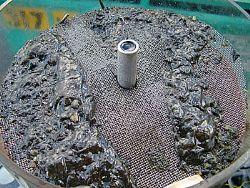Many diesel vehicle owners don’t realise that a micro organism can grow inside the fuel tank, feeding on the diesel fuel itself, especially if the vehicle isn’t used a lot – as often happens with old 4WDs or those used for occasional trips. And microbial contamination of diesel can cause owners of diesel-operated vehicles serious problems - but a diesel bug bloom can be killed off easily and permanently. Owner of De-Bug Advanced Diesel Solutions Jon Drumm says microbial contamination by bacteria, moulds and yeast of petroleum products is a widespread problem in the industry. Diesel fuel is a good food source for these organisms. Some reports have suggested that biodiesel is even more susceptible to contamination than standard diesel. Given optimum conditions aerobic diesel bugs can grow from a single sell weighing one millionth of a gram into a slimy algae mat weighing 10 kg within 24 hours. Other bugs grow more slowly but create problems during their development. For example, anaerobic or sulphur reducing bacteria produce hydrogen sulfide as a byproduct of their metabolism. Combined with moisture, this forms strong sulphuric acids. Microbes and their byproducts can degrade protective coatings such as paints, rubber, and metal oxide films and destroy chemical corrosion inhibitors. Evidence of infestation is visible biological sludge, slimes, and surface or interfacial deposits. These occur mainly in the fuel tank but can block filters. This fuel (which can smell like rotten eggs) is unreliable, and the consequences of using it could be dire. These include fuel filter clogging and blockage, coalescer (water removing filters) malfunctions, engine wear, corrosion of and blockages in the fuel system, damage to in-line instruments, and engine failure. Drumm says in the past infestations were typically treated by biocides. “However, many biocides are harmful chemicals and require careful handling by professionals,” he says. “Adding biocides to the fuel system may actually cause more problems as dead cells collecting on the bottom of the tank can still find their way into the fuel system, potentially leading to blocked filters and further engine damage. “And over time microbes may build up immunity to the biocides - occasional dosing can actually accelerate growth,” Drumm describes the De-Bug L140 purifier, a static magnetic inline device, as a tested and proven way to protect engines against microbial contamination. Micro-organisms are very vulnerable to magnetic waves. The organisms are single-celled, with a membrane surrounding each cell, and electrically charged ions that travel across this membrane are essential for the organism’s life. “Exposing the microbes to a strong, changing magnetic field, such as in the De-Bug, will ensure maximum destruction of the cells,” says Drumm. “This magnetic field in the unit is made possible by stacking three annular shaped permanent magnets on top of each other to form the patented Tri-Mag stack.” When the fuel and microbes flow between the magnets and through the centre of the middle magnet in the Tri-Mag pack, the flow path causes the microbial cells to experience the maximum levels of magnetic flux density from several different angles. This results in 24 changes in polarity of the magnetic field. “This kills them – the De-Bug has been proved to have a 97.5 percent efficiency in destroying the bugs in a single pass,” he says. The treated submicron particles then pass through the filter and burn up in the combustion process, helping reduce emissions. Drumm says installing a De-Bug even in an apparently uncontaminated engine will result in immediate benefits. These are improved fuel efficiency, reduced emissions, better protection of engine, filters, pumps and injectors, extended service life of filters, and a more reliable, efficient engine. De-Bug fuel treatment units are manufactured in New Zealand for local conditions and have been used by, among others, the armed forces, New Zealand fire service, Tranz Rail, Shell Oil, and the Mana coastguard. Pick-up, private vehicle, 4WD, small bus, small generator, farm machinery, and smaller sailboat engine owners are keen customers of the De-Bug L140. Operators of smaller commercial vehicles, 6 cylinder generators, smaller fuel bowsers, and agricultural equipment prefer the De-Bug L500. *
Perils of the Diesel Bug
Thursday, 21 February 2008




